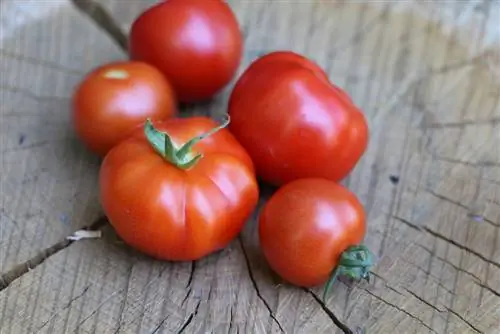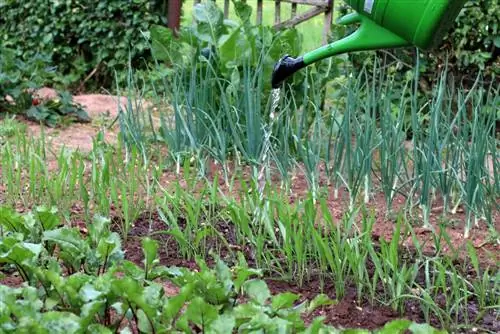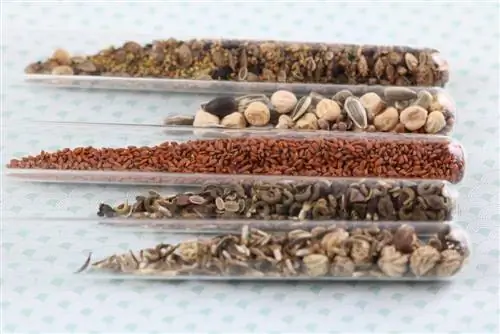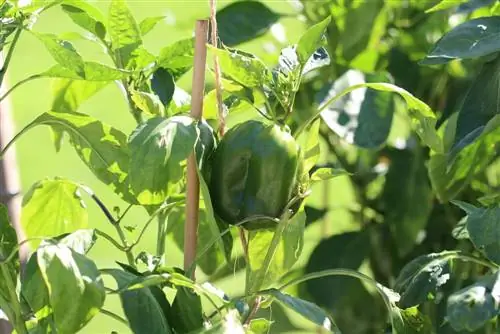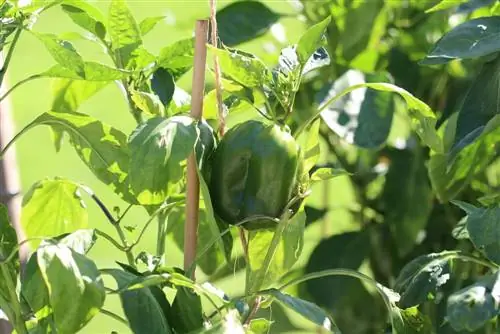- Author admin [email protected].
- Public 2023-12-17 03:39.
- Last modified 2025-06-01 06:48.
The right time is important when sowing vegetables. On the one hand, the plants must mature early in the year so that they can develop their full flavor and size. On the other hand, the seeds must not be placed in the ground too early so that they have ideal germination conditions and the young plants are not damaged by the late frosts. So that you always know when to sow which vegetables, we have put together an overview for you here.
germination conditions
The time for sowing also depends on the external conditions. The air temperature is not the deciding factor here. Rather, the average soil temperatures serve as an indicator of which vegetable plants currently have good germination conditions. The plants listed require a minimum temperature to germinate. The decisive factor is the temperature at a depth of 5 cm.
- 5 °C: carrots, radishes, radishes
- 11 °C: Peas
- 12 °C: lettuce, lamb's lettuce
- 13 °C: leek
- 14 °C: corn
- 15 °C: Kale
- 16 °C: spinach, pumpkin
- 17 °C: cauliflower, Brussels sprouts, red and white cabbage, broccoli, savoy cabbage
- 18 °C: onions, salsify
- 19 °C: chard, beetroot, white beetroot
- 20 °C: celery, Chinese cabbage
- above 20 °C: beans, peppers, tomatoes, zucchini
These minimum temperatures must be maintained over a period of approximately one week in order for the seeds to germinate.
Special sowing conditions
Some vegetables require very special conditions to germinate. Therefore, not all seeds can be sown under the same conditions. Most seeds germinate in warm temperatures and can therefore be sown indoors in early spring or, alternatively, sown outdoors a little later.
Dark Germ
Plant species that are classified as dark germinators really only germinate in the dark. So they must be covered with fine earth or sand to about twice the thickness of the seed.
Light germinator
The seeds of these vegetables require light to germinate. They are simply placed on the damp substrate and pressed lightly.
Cold germination
Plants that require a cold period to germinate before sowing are called cold germinators. In nature, this peculiarity is useful for plants that are native to temperate climates with cold winters. So that they do not germinate in autumn and freeze to death in the cold season, they are equipped with germ-inhibiting substances that are only slowly broken down by the cool temperatures. In these cases it is necessary to sow the seeds outdoors in autumn. Alternatively, it is also possible to store them in a bag with moist sand in the refrigerator for several weeks and then sow them indoors.
Pre-culture in the house
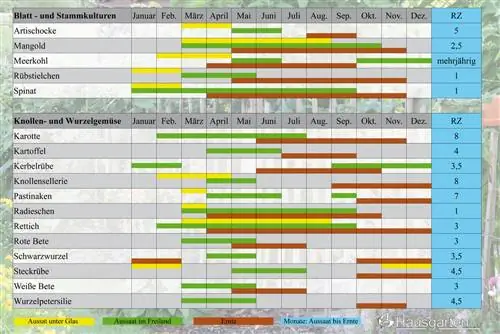
Pre-growing indoors is recommended, especially for vegetables that have a long ripening time or require warm temperatures. Depending on the plant species, sowing begins between February and April. Unfortunately, the lighting conditions here are not optimal at the beginning of the year. In most cases the rule applies: start the pre-culture on the windowsill about six weeks before sowing outdoors.
- Pre-treat seeds if necessary (cold period, soaking, dressing)
- only use clean sowing pots
- Substrate: nutrient-poor, sterile soil (cactus soil, special sowing soil)
- Moisten the soil
- Just sprinkle the light germinator on and press it on
- cover all other seeds with a little fine soil
- Label pots
- Protect from evaporation with a cover or transparent plastic bag
- Slightly reduce temperature from the point of germination
- very bright location
- Prick out plants from the first pair of real leaves
Before planting outdoors, the young vegetable plants must first be hardened off. To do this, they are first placed outside in a protected location at moderate temperatures. At the beginning, full sun should be avoided.
Cold frame/greenhouse
Thanks to the glass or plastic panes, the plants in a greenhouse are relatively well protected from short-term drops in temperature. This also applies to a cold frame. In addition, the air and ground heat up under the glass, so that the temperatures are permanently higher than outside. As a rule, depending on the location and type of cold frame or greenhouse, the seeds can only be sown indoors a few weeks after the pre-cultivation time. The same conditions apply to sowing and cultivation.
Direct sowing outdoors
Many types of vegetables can be sown directly to their final location in the outdoor bed. However, this should usually only be done when night frosts are no longer to be feared. An exception are cold germinators, which come into the garden soil in autumn or very early spring.
- Prepare the soil well
- should be loose and finely crumbly
- free from weeds
- Spread seeds widely onto the bed
- but row sowing is usually an option
- Keep your distance
- If necessary cover seeds with soil
- pour carefully (with a fine spray)
- possibly cover with a fleece/foil tunnel
- remove fleece after germination
- single to the appropriate planting distance
Sowing calendar by month
In order to get a better overview of which months you can sow which vegetables, a sowing calendar is designed by month. However, depending on the weather conditions and plant species, the timing may vary slightly for each individual. This means that the gardening year can be planned quite well in advance. If a spot in the bed becomes available during the year, it's easy to find out which plant will thrive. Of course, the prerequisite is always that crop rotation, crop rotation and mixed culture are observed.
Freeland
In general, it makes sense to sow cold germinators outdoors either in autumn or very early spring. From the end of April or beginning of May, direct sowing of almost all other vegetables is also possible. Winter vegetables are planted relatively late in the summer. All vegetables that have a short ripening period can be sown continuously until autumn. The prerequisite for sowing is, of course, that the soil is frost-free.
January
- Chervil (Chaerophyllum bulbosum)
- Garlic (Allium sativum)
- Spinach (Spinacia oleracea)
February
- Carrots (Daucus carota)
- Chervil (Chaerophyllum bulbosum)
- Broad beans (Vicia faba)
- Garlic (Allium sativum)
- Oil radish (Raphanus sativus var. oleifera)
- Leek (Allium porrum)
- Spinach (Spinacia oleracea)
March
- Broad beans (Vicia faba)
- Peas (Pisum sativum)
- Spring onion (Allium fistulosum)
- Carrots (Daucus carota)
- Chervil (Chaerophyllum bulbosum)
- Garlic (Allium sativum)
- Leek (Allium porrum)
- Chard (Beta vulgaris var. cicla)
- Oil radish (Raphanus sativa or oleifera)
- Radish (Raphanus sativus, R. caudatus)
- Beetroot (Beta vulgaris)
- Rübstielchen
- Spinach (Spinacia oleracea)
- Vineyard garlic (Allium vineale)
- Root parsley (Petroselinum crispum)
- Onions (Allium cepa)
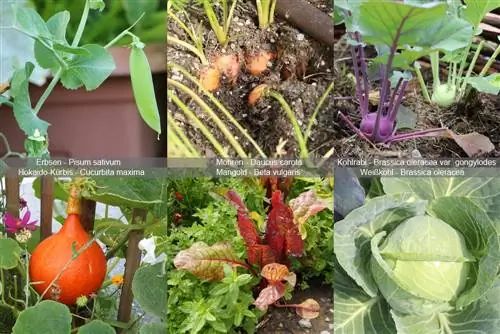
April
- Cauliflower (Brassica oleracea var. botrytis)
- Chinese cabbage (Brassica rapa subsp. pikenensis)
- Peas (Pisum sativum)
- early potato varieties (Solanum tuberosum)
- Spring onions (Allium fistulosum)
- Carrots (Daucus carota)
- Garlic (Allium sativum)
- Kohlrabi (Brassica oleracea var. gongylodes)
- Pumpkin (Cucurbita maxima)
- Leek (Allium porrum)
- May turnips (Brassica rapa)
- Chard (Beta vulgaris var. cicla)
- Maize (Zea mays)
- Parsnip (Pastinaca sativa)
- Radish (Raphanus sativus or caudatus)
- Beetroot (Beta vulgaris)
- Red cabbage (Brassica oleracea)
- Radish (Raphanus sativus)
- Romanesco (Brassica oleracea)
- Rübstielchen
- Black salsify (Scorzonera hispanica)
- Celery/celeriac (Apium graveolens)
- Spinach (Spinacia oleracea)
- Pointed cabbage (Brassica oleracea)
- Turnip (Brassica napus subsp. rapifera)
- White beetroot (Beta vulgaris)
- White cabbage (Brassica oleracea)
- Savoy cabbage (Brassica oleracea convar. capitata)
- Onions (Allium cepa)
May
- Artichoke (Cynara cardunculus)
- Cauliflower (Brassica oleracea var. botrytis)
- Broccoli (Brassica oleracea)
- Fresh bean (Phaseolus vulgaris)
- Chinese cabbage (Brassica rapa subsp. pikenensis)
- Peas (Pisum sativum)
- Spring onions (Allium fistulosum)
- Field bean (Phaseolus coccineus)
- Kale (Brassica oleracea convar. acephala)
- Cucumis (Cucumis sativus)
- Carrots (Daucus carota)
- Potatoes (Solanum tuberosum)
- Kohlrabi (Brassica oleracea var. gongylodes)
- Pumpkin (Cucurbita pepo or maxima)
- Leek (Allium porrum)
- May turnips (Brassica rapa)
- Maize (Zea mays)
- Chard (Beta vulgaris var. cicla)
- Sea kale (Crambe maritime)
- Palm cabbage (Brassica oleracea var. palmifolia)
- Parsnip (Pastinaca sativa)
- Radish (Raphanus sativus)
- Radish (Raphanus)
- Romanesco (Brassica oleracea)
- Brussels sprouts (Brassica oleracea)
- Beetroot (Beta vulgaris)
- Red cabbage (Brassica oleracea)
- Rübstielchen
- Snake beans (Vigna unguiculata)
- Black salsify (Scorzonera hispanica)
- Celery/celeriac (Apium graveolens)
- Spinach (Spinacia oleracea)
- Pointed cabbage (Brassica oleracea)
- Common beans (Phaseolus vulgaris)
- Turnip (Brassica napus subsp. rapifera)
- White beetroot (Beta vulgaris)
- White cabbage (Brassica oleracea)
- Savoy cabbage (Brassica oleracea convar. capitata)
- Root parsley (Petroselinum crispum)
- Zucchini (Cucurbita pepo)
- Onions (Allium cepa)
Tip:
Tomatoes and peppers can be sown directly outdoors from mid-May to early June, but pre-culture is more recommended as the plants are very sensitive.
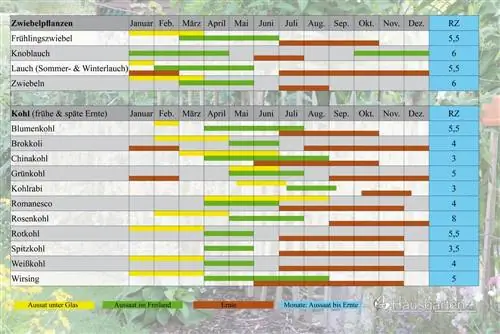
June
- Artichoke (Cynara cadununculus)
- Eggplant (Solanum melongena)
- Cauliflower (Brassica oleracea var. botrytis)
- Bush beans (Phaseolus vulgaris)
- Broccoli (Brassica oleracea)
- Chinese cabbage (Brassica rapa subsp. pikenensis)
- Peas (Pisum sativum)
- Spring onions (Allium fistulosum)
- Kale (Brassica oleracea convar. acephala)
- Cucumis (Cucumis sativus)
- Carrots (Daucus carota)
- Potatoes (Solanum tuberosum)
- Kohlrabi (Brassica oleracea var. gongylodes)
- Chard (Beta vulgaris var. cicla)
- Turnip (Brassica rapa)
- Maize (Zea mays)
- Sea kale (Crambe maritime)
- Palm cabbage (Brassica oleracea var. palmifolia)
- Parsnip (Pastinaca sativa)
- Radish (Raphanus sativus)
- Radish (Raphanus)
- Romanesco (Brassica oleracea)
- Brussels sprouts (Brassica oleracea)
- Snake bean (Vigna unguiculata)
- Spinach (Spinacia oleracea)
- Common bean (Phaseolus vulgaris)
- Turnip (Brassica napus subsp. rapifera)
- Savoy cabbage (Brassica olerace convar. capitata)
- Zucchini (Cucurbita pepo)
July
- Cauliflower (Brassica oleracea var. botrytis), winter harvest
- Peas (Pusum sativum)
- Fresh bean (Phaseolus vulgaris)
- Chinese cabbage (Brassica rapa subsp. pekinensis)
- Kale (Brassica oleracea convar. acephala)
- Autumn clouds (Brassica rapa)
- Carrots (Daucus carota)
- Kohlrabi (Brassica oleracea var. gongylodes)
- Turnip (Brassica rapa)
- Chard (Beta vulgaris var. cicla)
- Radish (Raphanus sativus)
- Radish (Raphanus)
- Brussels sprouts (Brassica oleracea)
- Snake bean (Vigna unguiculata)
- Spinach (Spinacia oleracea)
- Common bean (Phaseolus vulgaris)
- Savoy cabbage (Brassica oleracea convar. capitata)
- Zucchini (Cucurbita pepo)
August
- Chinese cabbage (Brassica rapa subsp. pekinensis)
- Autumn clouds (Brassica rapa)
- Kohlrabi (Brassica oleracea var. gongylodes)
- Chard (Beta vulgaris var. cicla)
- Radish (Raphanus sativus)
- Radish (Raphanus)
- Spinach (Spinacia oleracea)
- Savoy cabbage (Brassica oleracea convar. capitata)
September
- Chervil (Chaerophyllum bulbosum)
- Chard (Beta vulgaris var. cicla)
- Parsnip (Pastinaca sativa)
- Radish (Raphanus sativus)
- Radish (Raphanus)
- Spinach (Spinacia oleracea)
October
- - Chervil (Chaerophyllum bulbosum)
- - Garlic (Allium sativum)
- - Chard (Beta vulgaris var. cicla)
- - Sea kale (Crambe maritime)
November
- Chervil (Chaerophyllum bulbosum)
- Garlic (Allium sativum)
- Sea kale (Crambe maritime)
December
- Chervil (Chaerophyllum bulbosum)
- Garlic (Allium sativum)
- Sea kale (Crambe maritime)
Tip:
In most cases, early plants can be planted out at the same time as outdoor sowing.
Sowing in the cold frame/greenhouse
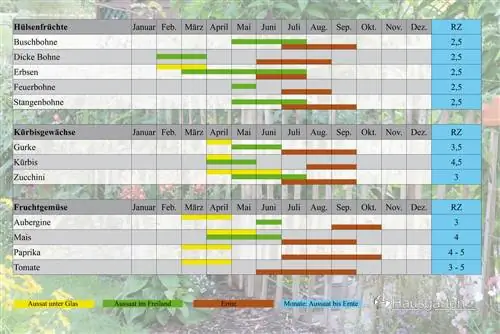
Due to the protected conditions under glass, the seeds can sometimes be planted in the ground many weeks before sowing outdoors. Please note that not all vegetables can be grown under glass. Cold germs such as chervil require a period of frost and should therefore be sown directly outdoors. Carrots tend to become sparse and woody when transplanted. If they are sown in the cold frame, they should also mature there.
January
- Spring onions (Allium fistulosum)
- Leek (Allium porrum)
- Red cabbage (Brassica oleracea)
- Rübstielchen
- Spinach (Spinacia oleracea)
- Turnip (Brassica napus subsp. rapifera)
- White cabbage (Brassica oleracea)
- Savoy cabbage (Brassica olerace convar. capitata)
- Onions (Allium cepa)
February
- Cauliflower (Brassica oleracea var. botrytis)
- Broccoli (Brassica oleracea)
- Peas (Pisum sativum)
- Spring onions (Allium fistulosum)
- Sea kale (Crambe maritime)
- Brussels sprouts (Brassica oleracea)
- Red cabbage (Brassica oleracea)
- Rübstielchen
- Turnip (Brassica napus subsp. rapifera)
- Spinach (Spinacia oleracea)
- Celery/celeriac (Apium graveolens)
- White cabbage (Brassica oleracea)
- Savoy cabbage (Brassica olerace convar. capitata)
- Onions (Allium cepa)
March
- Artichoke (Cynara cardunculus)
- Eggplant (Solanum melongena)
- Broccoli (Brassica oleracea)
- Chinese cabbage (Brassica rapa subsp. pekinensis)
- Peas (Pisum sativum)
- Spring onions (Allium fistulosum)
- Potato varieties (Solanum tuberosum)
- Kohlrabi (Brassica oleracea var. gongylodes)
- Chard (Beta vulgaris var. cicla)
- Sea kale (Crambe maritime)
- Peppers (Capsicum)
- Parsnip (Pastinaca sativa)
- Radish (Raphanus sativus)
- Radish (Raphanus)
- Brussels sprouts (Brassica oleracea)
- Red cabbage (Brassica oleracea)
- Celery/celeriac (Apium graveolens)
- Tomatoes (Solanum lycopersicum)
- White cabbage (Brassica oleracea)
- Savoy cabbage (Brassica olerace convar. capitata)
- Onions (Allium cepa)
April
- Artichoke (Cynara cardunculus)
- Eggplant (Solanum melongena)
- Broccoli (Brassica oleracea)
- Chinese cabbage (Brassica rapa subsp. pekinensis)
- Cucumis (Cucumis sativus)
- Potato varieties (Solanum tuberosum)
- Kohlrabi (Brassica oleracea var. gongylodes)
- Pumpkin (Cucurbita maxima)
- Chard (Beta vulgaris var. cicla)
- Sea kale (Crambe maritime)
- Maize (Zea mays)
- Peppers (Capsicum)
- Radish (Raphanus)
- Romanesco (Brassica oleracea)
- Brussels sprouts (Brassica oleracea)
- Tomatoes (Solanum lycopersicum)
- Zucchini (Cucurbita pepo)
May
- Chinese cabbage (Brassica rapa subsp. pekinensis)
- Kale (Brassica oleracea convar. acephala)
- Kohlrabi (Brassica oleracea var. gongylodes)
- Chard (Beta vulgaris var. cicla)
- Maize (Zea mays)
- Radish (Raphanus)
- Romanesco (Brassica oleracea)
- Zucchini (Cucurbita pepo)
June
- Chinese cabbage (Brassica rapa subsp. pekinensis)
- Kale (Brassica oleracea convar. acephala)
- Kohlrabi (Brassica oleracea var. gongylodes)
- Chard (Beta vulgaris var. cicla)
- Radish (Raphanus)
- Romanesco (Brassica oleracea)
- Zucchini (Cucurbita pepo)
July
- Chard (Beta vulgaris var. cicla)
- Kohlrabi (Brassica oleracea var. gongylodes)
- Radish (Raphanus)
- Romanesco (Brassica oleracea)
August
- Chard (Beta vulgaris var. cicla)
- Radish (Raphanus)
November
Turnip (Brassica napus subsp. rapifera)
December
Turnip (Brassica napus subsp. rapifera)
Deviations
Since the individual varieties of different vegetables sometimes differ greatly from each other and new varieties are constantly appearing on the market, it is important to follow the exact sowing instructions on the seed packaging. The sowing times given here serve as guidelines only and may vary slightly depending on the region. Particularly in warm wine-growing regions, much earlier outdoor cultivation is often possible.
Conclusion
While some vegetables such as tomatoes and peppers always have to be grown warm, most vegetables can be pre-cultivated both outdoors and indoors, or in a cold frame or greenhouse. As a rule, vegetable plants are sown for pre-breeding about six weeks before sowing outdoors. The young vegetable plants are transplanted when they are sown outdoors (at six to eight weeks).


